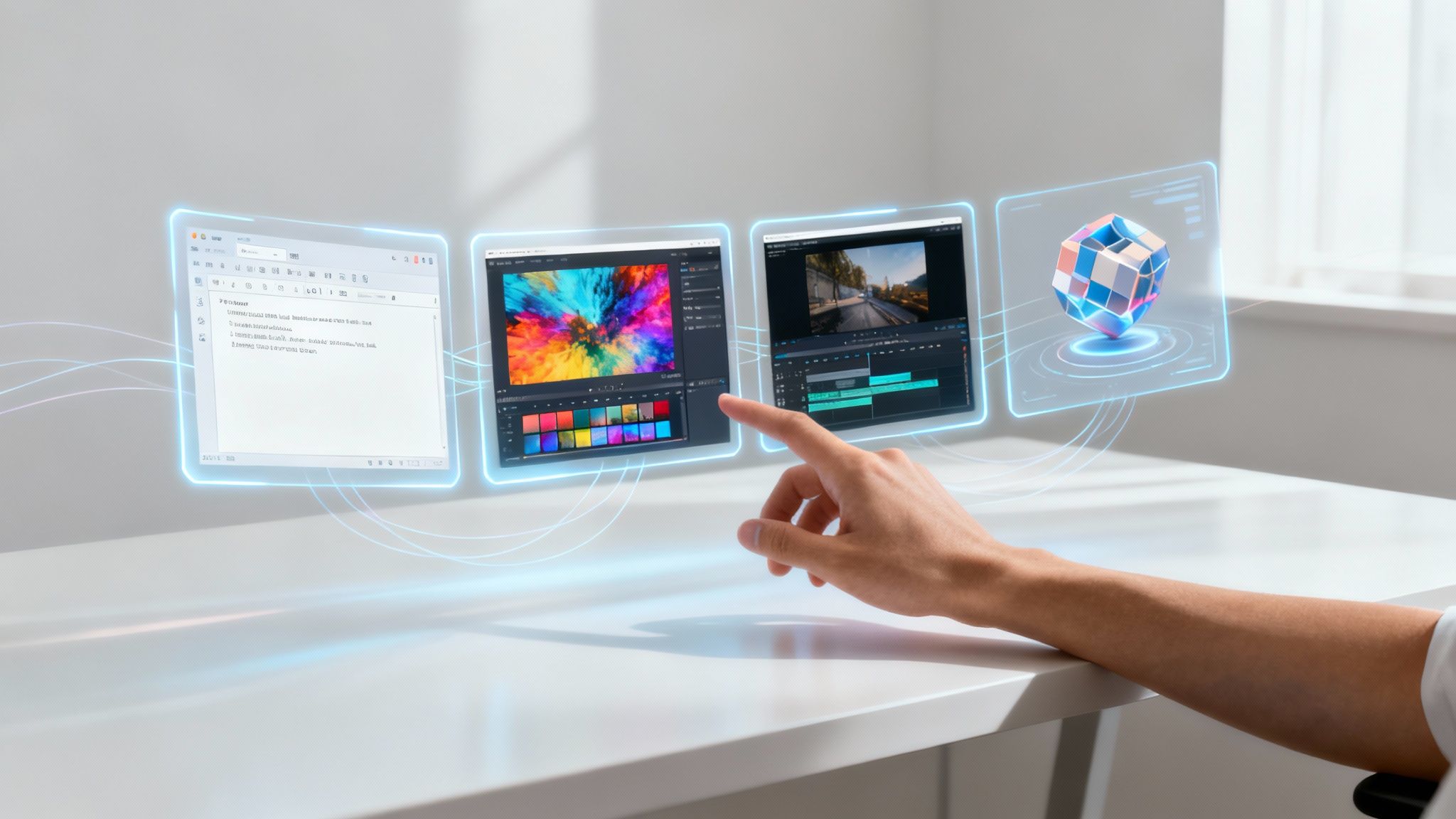The content creation process is undergoing a significant transformation, driven by a new generation of sophisticated AI tools. For creative teams, marketers, designers, and developers, these platforms are no longer a novelty but essential components of an efficient, scalable, and compliant workflow. They offer powerful solutions to common bottlenecks, from generating initial ideas and drafting copy to producing high-quality visuals, video, and even 3D assets. This shift allows creators to focus less on repetitive tasks and more on the strategic and innovative aspects of their work, all while operating within a secure and responsible framework.
This comprehensive guide is designed to help you navigate the expansive market of AI tools for content creation. We will move beyond surface-level descriptions to provide a detailed analysis of the most impactful platforms available, with a focus on visual creative work. Our goal is to equip you with the insights needed to select the right tools for your specific projects, whether you're a project manager overseeing a creative pipeline, a 3D designer building virtual environments, or a marketer aiming to scale content output responsibly. To truly leverage AI, it's essential to understand how to approach content creation automation for better marketing, utilizing AI strategies to boost efficiency and output. For a deeper dive into this topic, consider reading about Mastering Content Creation Automation.
Each entry in this listicle offers a practical evaluation, including:
- Key Features: A focused look at what makes each tool unique.
- Ideal Use Cases: Specific scenarios where the platform excels.
- Pricing Structures: Clear information to help with budget planning.
- Limitations: An honest assessment of potential drawbacks.
We've organised this resource to be scannable and straightforward, with direct links and screenshots for every tool. This will help you quickly compare options and make an informed decision, ensuring you can responsibly integrate these powerful technologies into your creative workflows.
1. Virtuall
Best For: Studios and creative teams needing a unified, enterprise-grade OS for multi-format AI visual asset generation.
Virtuall positions itself not merely as another tool, but as a comprehensive Creative Operating System designed for the rigorous demands of professional studios, game developers, and enterprise brands. It centralises the entire visual creative pipeline, from initial AI-powered concept generation across 3D, image, and video formats to final asset delivery, all within a single, secure browser-based workspace. This integrated approach is its core differentiator, making it a standout choice among ai tools for content creation.

Its strength lies in its ability to accelerate workflows by combining top-tier AI models with robust project management features. Teams can generate visual assets from text or image prompts, compare outputs from different AI engines to find the perfect fit, and manage everything using visual Kanban boards. The platform is explicitly built for team-first collaboration, featuring in-browser review, direct visual annotation on 3D models and video frames, and version control, significantly reducing feedback friction and approval cycles.
For enterprises, Virtuall’s focus on compliance, intellectual property ownership, and security is a critical advantage. Built in Europe with an emphasis on enterprise-grade infrastructure, it ensures teams maintain creative control and have a clear audit trail for all generated assets. A unified token system also provides centralised control over AI expenditure, a crucial feature for managing budgets across complex visual projects.
Key Features & Strengths:
- Multi-Format Generation: Seamlessly create and iterate on 3D models, high-resolution images, and motion clips within one unified environment.
- Team-Centric Workflow: Utilise shared workspaces, Kanban boards, and in-line visual annotation tools to streamline collaboration and approvals.
- Enterprise-Ready & Secure: Prioritises IP ownership and compliance, offering a secure platform trusted by global creative teams.
- Centralised Cost Control: A single token system simplifies budget management across various AI engines and asset types.
Limitations:
- No Public Pricing: Access and cost details are only available by booking a demo, which may not suit teams needing immediate access or transparent pricing.
- Cloud-Based Dependency: Its browser-based nature may not be ideal for studios requiring highly specialised, on-premise, or offline workflows.
Website: https://virtuall.pro
2. OpenAI – ChatGPT
Best For: Secure, general-purpose text generation to support visual creative briefs, scripts, and project outlines.
As a foundational platform, OpenAI's ChatGPT excels as a high-quality, general-purpose tool for a vast range of text-based tasks that support the visual creation process. It serves as a powerful starting point for drafting everything from social media captions and blog post outlines to complex creative briefs and video scripts. Its versatility makes it an indispensable asset for creative teams looking to streamline initial brainstorming and drafting phases securely.

What distinguishes ChatGPT is its robust ecosystem and enterprise-readiness. Beyond basic text generation, its multimodal capabilities now include image creation via DALL-E 3, making it a comprehensive hub for diverse creative needs. For project managers and creative directors, the ability to create custom GPTs for specific workflows, such as maintaining a consistent brand voice or generating formatted reports, is a significant advantage. This level of customisation helps integrate ai generated content seamlessly and responsibly into established team processes. You can discover more about the fundamentals of AI-generated content to better leverage these tools.
Key Features and Implementation
- Plan Tiers: Access starts with a capable Free version, while paid tiers (Plus, Pro, Business) unlock higher usage limits, advanced models like GPT-4, and team-focused features.
- Custom GPTs: Teams can build specialised assistants trained on their own data and guidelines to automate repetitive creative or administrative tasks, ensuring compliance and consistency.
- Enterprise Controls: For larger organisations, ChatGPT provides a secure, compliant environment with clear data privacy controls, making it a safe choice for enterprise adoption.
- Pros: High-quality output, strong integration ecosystem, excellent for general-purpose creative support.
- Cons: Fine-tuning brand voice requires more initial setup than specialised copywriting tools; core features are locked behind subscriptions.
Website: https://openai.com/chatgpt
3. Adobe Firefly
Best For: Creating commercially safe visual assets within a deeply integrated, enterprise-grade creative ecosystem.
Adobe Firefly positions itself as an enterprise-grade generative AI, deeply integrated into the Adobe Creative Cloud ecosystem. It excels at creating commercially safe images, vectors, and other visual assets, making it a reliable choice for producing thumbnails, social media posts, and brand-aligned promotional materials. For creative teams already reliant on Adobe's suite, Firefly provides a seamless workflow, allowing for the generation of assets that can be immediately refined in industry-standard tools like Photoshop and Illustrator.
What distinguishes Firefly is its focus on commercial safety and seamless integration. Trained on Adobe Stock's licensed library and openly licensed content, it is designed to be commercially safe, with Adobe even offering enterprise indemnification for content generated. This makes it one of the most compelling ai tools for content creation for organisations prioritising compliance and brand safety. For art directors and marketing teams, this means assets can be deployed with confidence, bridging the gap between generative speed and enterprise-level governance. You can explore how it compares to other leading solutions and learn more about the best AI for image generation to find the perfect fit.
Key Features and Implementation
- Plan Tiers: Access is offered through various Adobe Creative Cloud subscriptions and standalone Firefly plans, with monthly generative credits dictating usage volume.
- Deep Integration: Native functionality within Photoshop, Express, and Illustrator allows for generative fill, text-to-image, and text-to-vector workflows without leaving the application.
- Commercial Safety: Outputs are designed to be safe for commercial use, a critical consideration for corporate marketing and creative production.
- Pros: Seamless handoff to professional Adobe editing tools, strong enterprise and commercial safety positioning, and scales effectively from individual creators to large teams.
- Cons: The best value is realised when already invested in the Adobe ecosystem; video and audio generation capabilities are limited and tied to credit consumption on lower-tier plans.
Website: https://www.adobe.com/creativecloud/firefly.html
4. Canva – Magic Studio
Best For: Rapid production of on-brand marketing visuals and social media content within a secure, template-driven platform.
Canva’s Magic Studio democratises visual content creation by integrating a suite of AI tools directly into its user-friendly design platform. It is an excellent choice for marketing teams and non-designers needing to rapidly produce high-quality social media posts, presentations, and marketing collateral. The platform excels at transforming simple text prompts into polished visuals, leveraging a vast library of templates and assets to ensure brand consistency and speed up workflows.

What sets Canva’s offering apart is its accessibility and integrated governance. Tools like Magic Write for copy, Magic Design for layouts, and Magic Media for text-to-image and video generation are embedded within the familiar Canva interface. This removes the friction of switching between different ai tools for content creation. For project managers and creative directors, the inclusion of brand kits, team collaboration features, and enterprise-grade admin controls provides crucial governance. The platform’s AI safety layer, Canva Shield, also underscores its commitment to providing a responsible and secure environment for enterprise use.
Key Features and Implementation
- Plan Tiers: A generous free plan provides basic access, while paid subscriptions (Pro and Teams) unlock premium AI features, larger asset libraries, and advanced collaboration controls.
- Integrated AI Suite: Magic Studio combines multiple AI capabilities, including text generation, text-to-image, text-to-video, and automated background removal, all within one unified platform.
- Brand Governance: Enterprise-level features allow teams to lock brand templates, manage asset access, and maintain strict visual consistency across all creative outputs.
- Pros: Extremely low learning curve, ideal for non-designers; powerful template and stock library enhanced with AI; strong team-focused features for brand management.
- Cons: Premium AI tools are gated behind paid tiers with monthly usage caps; specific feature availability and pricing can be complex across different plans.
Website: https://www.canva.com/magic/
5. Jasper
Best For: Generating compliant, on-brand marketing copy to support visual campaigns and creative projects.
Jasper is a marketing-focused AI copywriting platform specifically engineered for creative and marketing teams. It excels at generating on-brand copy across various formats, including blog posts, ad campaigns, social media updates, and product descriptions. Its core strength lies in translating marketing briefs into polished first drafts, significantly accelerating the content production cycle for teams aiming for speed, scale, and compliance.
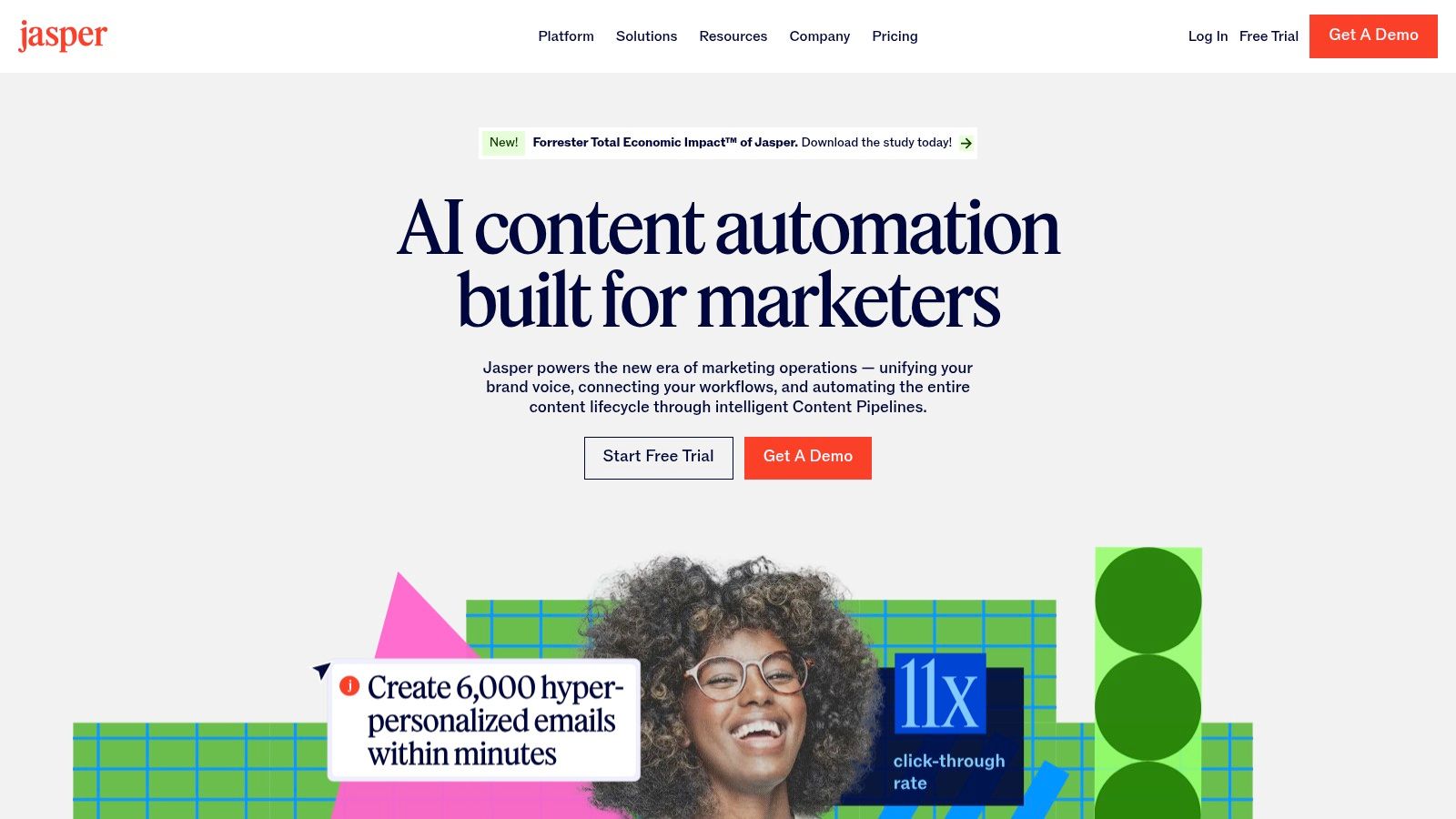
What sets Jasper apart from generalist AI tools is its deep integration into the marketing workflow. The platform’s Brand Voice and Style Guide features allow creative directors and brand managers to embed their unique tonal guidelines, ensuring all ai generated content remains consistent and compliant. This makes it one of the most effective ai tools for content creation when brand integrity is paramount. For larger organisations, its structured campaign templates and team collaboration features provide a controlled, efficient environment for producing high-volume marketing materials that support visual assets.
Key Features and Implementation
- Plan Tiers: Pricing is organised into transparent seat-based plans. A Creator tier is available for individuals, while Pro and custom Business plans offer advanced collaboration and brand control features for teams.
- Brand Voice & Style Guides: Upload style guides, product catalogues, and brand messaging to train the AI, ensuring all outputs are aligned with your company’s specific voice and terminology.
- Team-Focused Workflows: Offers built-in campaign templates and collaboration tools designed to take content from brief to final draft within a single, organised platform.
- Pros: Highly tailored to marketing operations, strong brand control features, transparent pricing models for teams.
- Cons: Less focused on direct visual generation; the most powerful features are locked behind higher-tier plans.
Website: https://www.jasper.ai
6. Copy.ai
Best For: Automating and scaling compliant text-based workflows that support visual content strategies.
Copy.ai positions itself as an enterprise-grade platform that moves beyond simple text generation into complex workflow automation. It excels at helping teams orchestrate and scale their content strategies by combining AI chat with powerful agents and customisable workflows. This approach allows creative teams and marketers to automate research, drafting, and personalisation across large-scale campaigns, making it one of the most robust ai tools for content creation for supporting visual and multimedia projects at the team level.
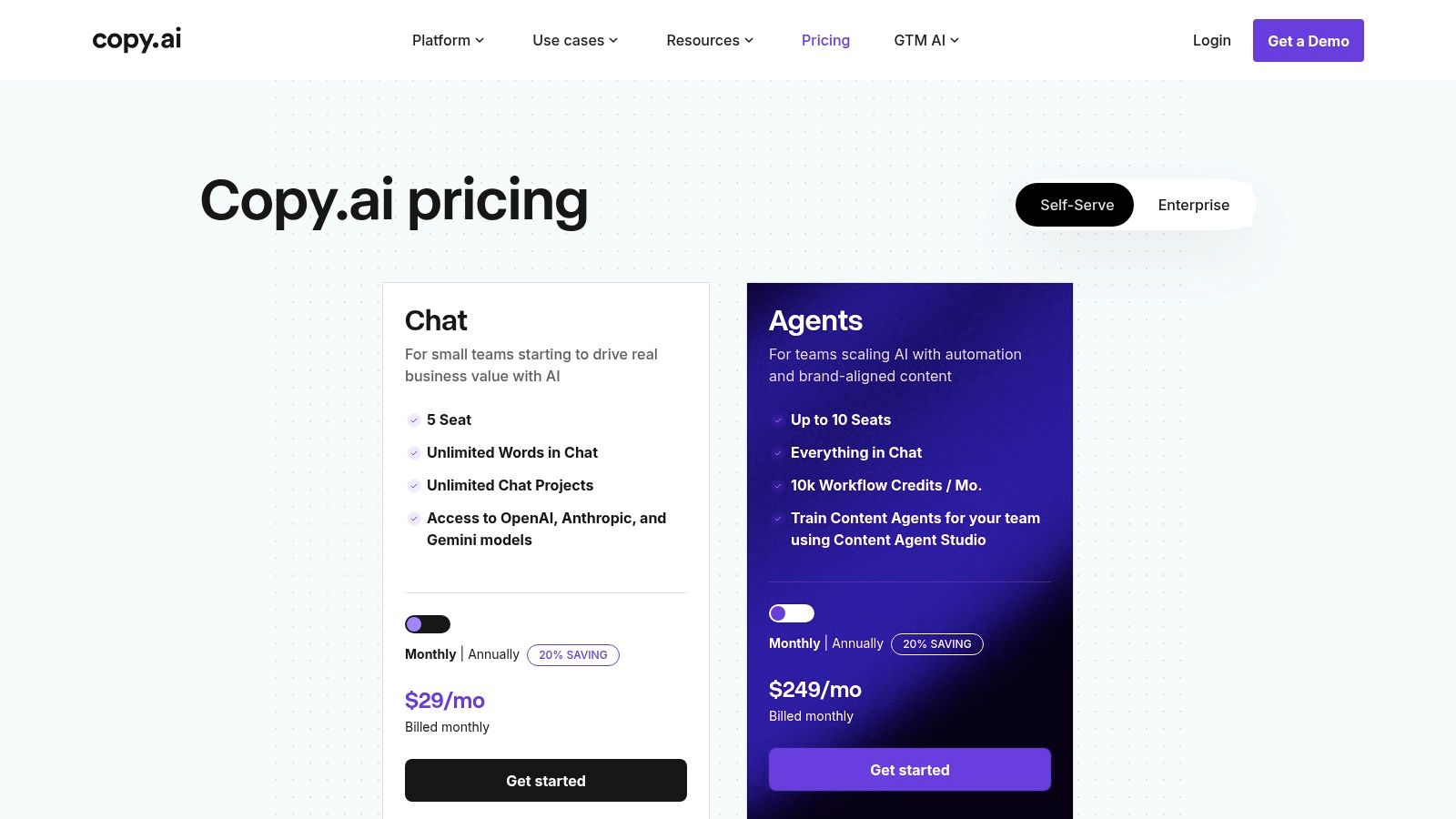
What makes Copy.ai stand out is its model-agnostic architecture and emphasis on process automation. Users are not locked into a single AI provider; they can leverage models from OpenAI, Anthropic, and Google Gemini within their workflows. This flexibility is crucial for enterprises needing to optimise for cost, performance, and specific task suitability. For creative directors and project managers, the ability to build and deploy automated workflows means less time on repetitive tasks and more time on strategic initiatives, ensuring a consistent and compliant output across all projects. The guided team onboarding process also ensures a smooth and secure adoption into existing creative processes.
Key Features and Implementation
- Plan Tiers: A Free plan is available for individuals to get started. Paid plans (Pro, Team, Enterprise) unlock unlimited words in Chat, advanced workflow automation with credits, and enterprise-level security controls.
- Agents and Workflows: Teams can design automated sequences that perform tasks like researching topics, drafting articles, and personalising sales outreach, all fuelled by workflow credits.
- Multi-Model Access: The platform integrates multiple leading AI models, providing the flexibility to choose the best engine for any given creative or analytical task.
- Pros: Strong balance of content generation and powerful automation, unlimited words in Chat on paid tiers, and excellent for scaling team-based content operations.
- Cons: Less focused on visual generation; automation features rely on a credit system that requires careful cost management.
Website: https://www.copy.ai/prices
7. Descript
Best For: Efficiently editing and repurposing video and audio content with a secure, text-based workflow.
Descript revolutionises audio and video editing by transforming media into a text document, allowing creators to edit recordings as easily as they would a Word file. It excels at rapidly turning raw footage from podcasts, webinars, and interviews into polished visual content. This text-based workflow dramatically speeds up the rough-cut process, making it an essential tool for teams focused on fast-turnaround social video clips and narrative content.
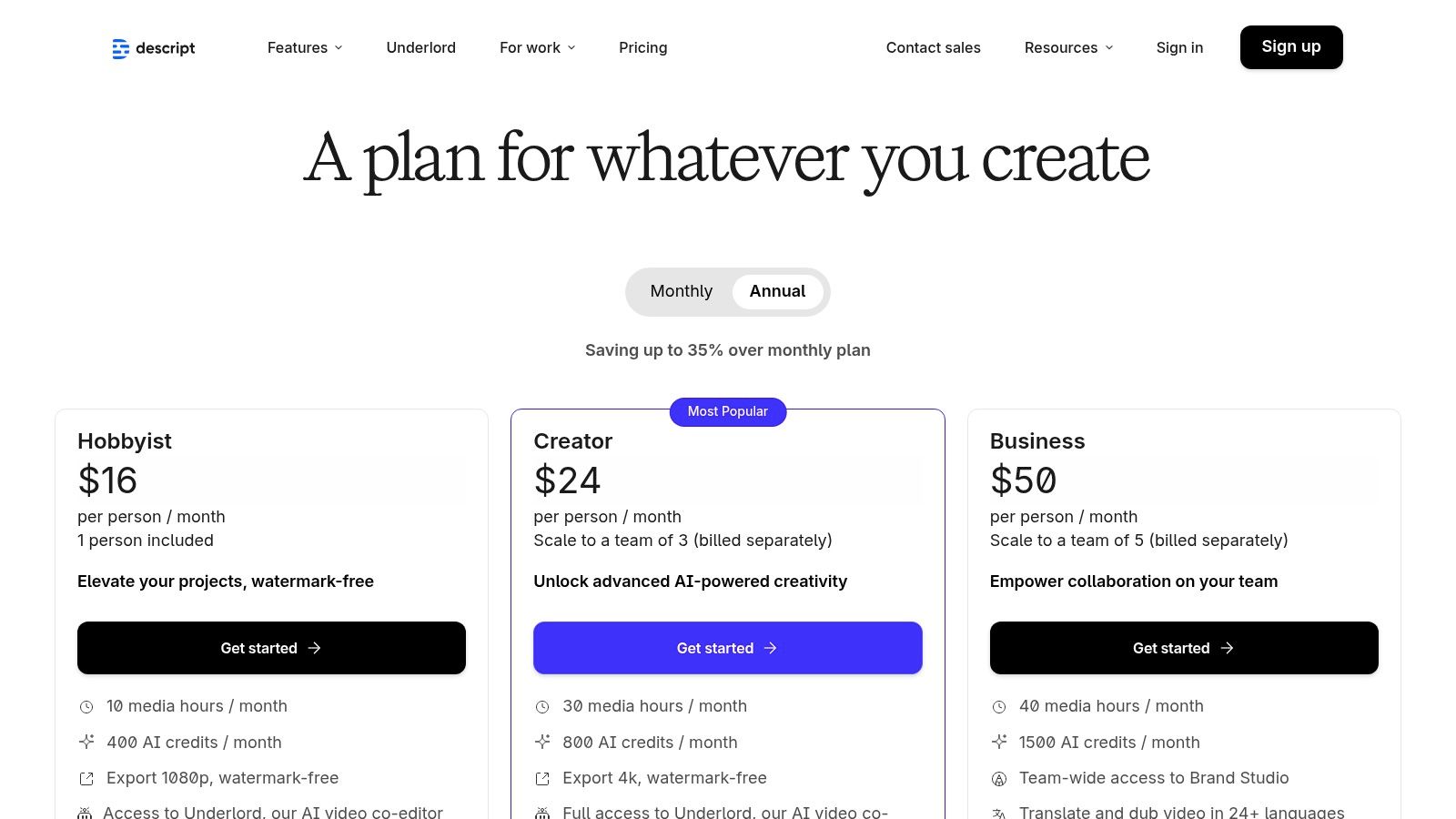
What truly sets Descript apart is its suite of integrated AI features designed for efficiency and collaboration. The platform can automatically remove filler words, clone voices to correct audio mistakes with its Overdub feature, and provide an AI co-editor to help structure and summarise content. For creative directors and producers, this means less time spent on tedious manual edits and more time focused on storytelling. Its all-in-one nature, which includes remote recording via SquadCast, stock media libraries, and automatic captioning, makes it one of the most powerful ai tools for content creation in the video and podcasting space for enterprise teams.
Key Features and Implementation
- Plan Tiers: A Free plan offers basic transcription and editing, while paid Creator and Pro tiers provide more transcription hours and advanced AI features. A custom Enterprise plan is available for larger teams needing enhanced security and support.
- Text-Based Editing: Edit video and audio by simply deleting or rearranging text in the automatically generated transcript. This is highly intuitive for collaborators without traditional video editing experience.
- AI-Powered Tools: Features like Studio Sound for audio enhancement, Overdub for voice cloning, and automatic filler word removal streamline the post-production workflow significantly.
- Pros: Extremely fast rough-cut to publish workflow, built-in stock media and captions streamline social output, includes SquadCast remote recording in subscriptions.
- Cons: The new resource model (media minutes + AI credits) may require some recalibration for existing users; advanced avatars and multilingual dubbing are on higher tiers.
Website: https://www.descript.com/pricing
8. Runway
Best For: Prototyping and generating cutting-edge AI video and motion assets in a controlled, scalable environment.
Runway has established itself as a leader in state-of-the-art AI video generation and editing. Its powerful Gen-3 and Gen-4 models enable creative teams to produce high-fidelity motion assets, ad creatives, and complex visual explainers without requiring a full studio setup. This makes it an essential tool for prototyping and rapidly iterating on visual concepts, significantly cutting down production time while maintaining creative control.
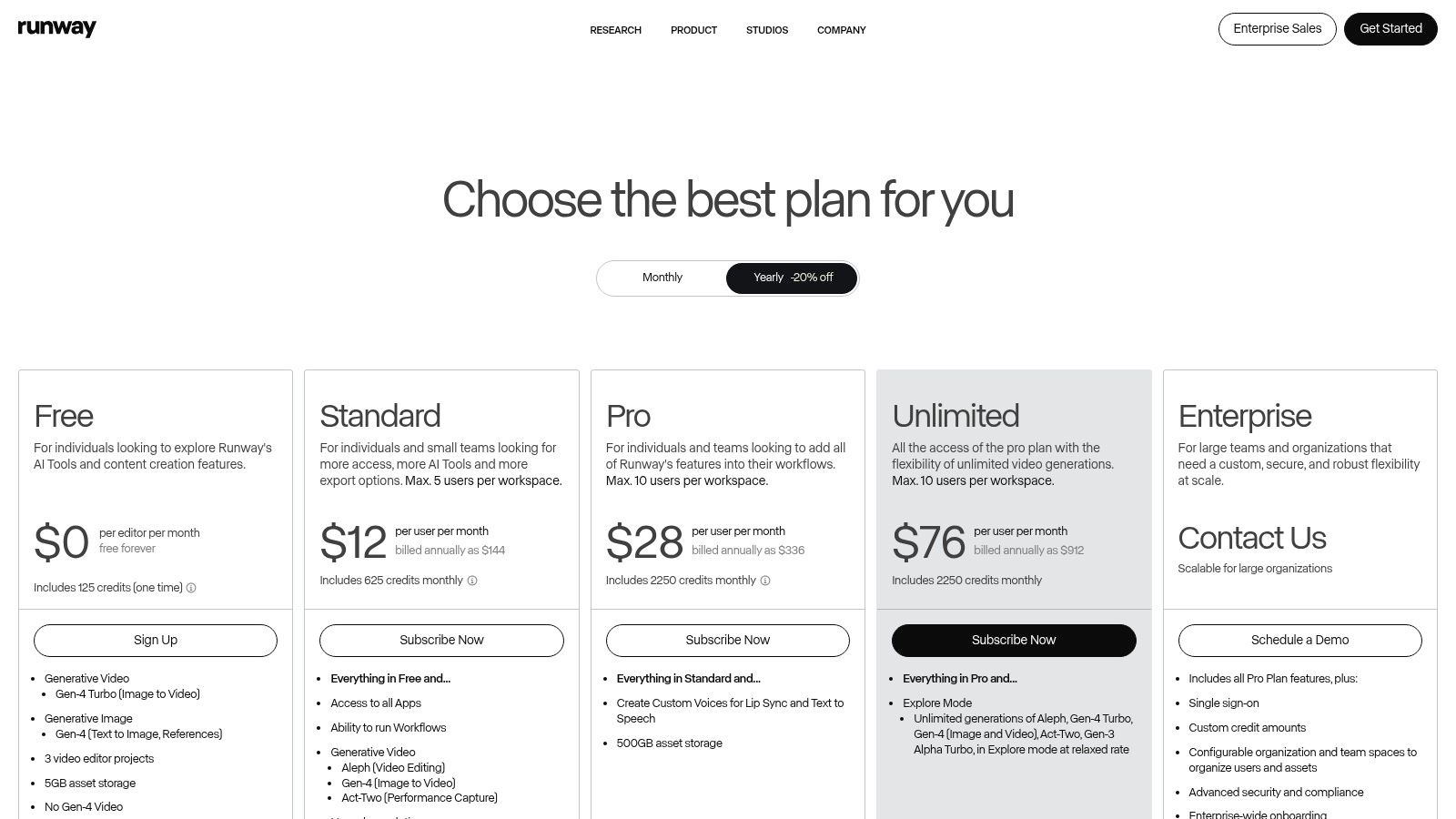
What distinguishes Runway is its focus on providing a comprehensive suite of motion and image tools within a single, cohesive platform. Beyond text-to-video, it offers image generation, advanced editing capabilities, and high-resolution upscaling, positioning itself as a versatile hub for motion graphics artists and video producers. The platform’s credit-based system and clear API pricing provide predictable budgeting for project managers, allowing teams to scale their use of ai tools for content creation responsibly. This predictable cost structure is crucial for enterprises managing creative budgets. You can explore a deeper comparison and discover more about the best AI video generators to see how Runway fits into the broader ecosystem.
Key Features and Implementation
- Plan Tiers: Offers a Free tier for basic access, with Standard, Pro, and Unlimited plans providing more credits and faster processing. Enterprise solutions are available for larger teams needing advanced security and control.
- Gen-3/Gen-4 Models: Provides access to cutting-edge text-to-video and image-to-video models for creating highly realistic and stylised motion content.
- Predictable API Costs: Features a clear per-second and per-asset API pricing model, which is ideal for organisations needing to forecast and control content production expenditure.
- Pros: Leading-edge video generation models, allows for rapid prototyping of motion assets, transparent API costs for budget planning.
- Cons: "Unlimited" plans may have speed and concurrency limitations; high-quality upscaling from SD to 4K requires significant time and additional credits.
Website: https://runwayml.com/pricing
9. Synthesia
Best For: Scalable production of enterprise-grade training and marketing videos using compliant AI avatars.
Synthesia is a leading AI video generation platform that transforms scripts into professional, presenter-led videos without the need for cameras or microphones. It excels at producing high-quality training materials, product walkthroughs, and marketing explainers at scale. For creative teams and corporate trainers, this dramatically reduces the time and cost associated with traditional video production, allowing for rapid creation and localisation of content in a secure environment.

What distinguishes Synthesia is its enterprise-focus and robust avatar customisation. While its large library of stock avatars is a strong starting point, the ability to create a custom digital twin of a key company presenter ensures brand consistency and a personal touch. Combined with its multilingual AI dubbing and screen recording features, it is one of the most comprehensive ai tools for content creation when it comes to scalable corporate video. The platform is designed for team collaboration, providing a secure and centralised workspace for creating and managing video assets responsibly.
Key Features and Implementation
- Plan Tiers: Pricing starts with a Personal plan for individuals. The Enterprise plan is tailored for organisations, offering custom avatars, SSO, advanced security, and dedicated support.
- AI Avatars and Voices: Choose from over 160 stock avatars or create a custom one. The platform supports over 130 languages and accents, enabling efficient global content rollouts.
- Enterprise-Ready: Features like brand kits, collaborative workspaces, and SCORM exports make it easy to integrate Synthesia into existing learning management systems and brand guidelines.
- Pros: Radically speeds up production of on-brand talking-head videos, strong enterprise controls and security, excellent language coverage for global teams.
- Cons: Over-reliance on avatars can feel less authentic for certain brand campaigns; video minute and credit caps apply to lower-tier plans.
Website: https://www.synthesia.io/pricing
10. ElevenLabs
Best For: Creating studio-quality, compliant voiceovers and audio dubs for visual content at scale.
ElevenLabs sets the standard for high-fidelity, AI-driven audio, offering studio-quality text-to-speech, voice cloning, and multilingual dubbing. It is a critical tool for creative teams needing professional-grade voiceovers for videos, podcasts, and large-scale localisation projects. The platform's ability to generate exceptionally natural and emotive voices makes it an essential asset for adding a polished audio layer to visual content, moving beyond robotic-sounding narration into a secure, enterprise-ready solution.
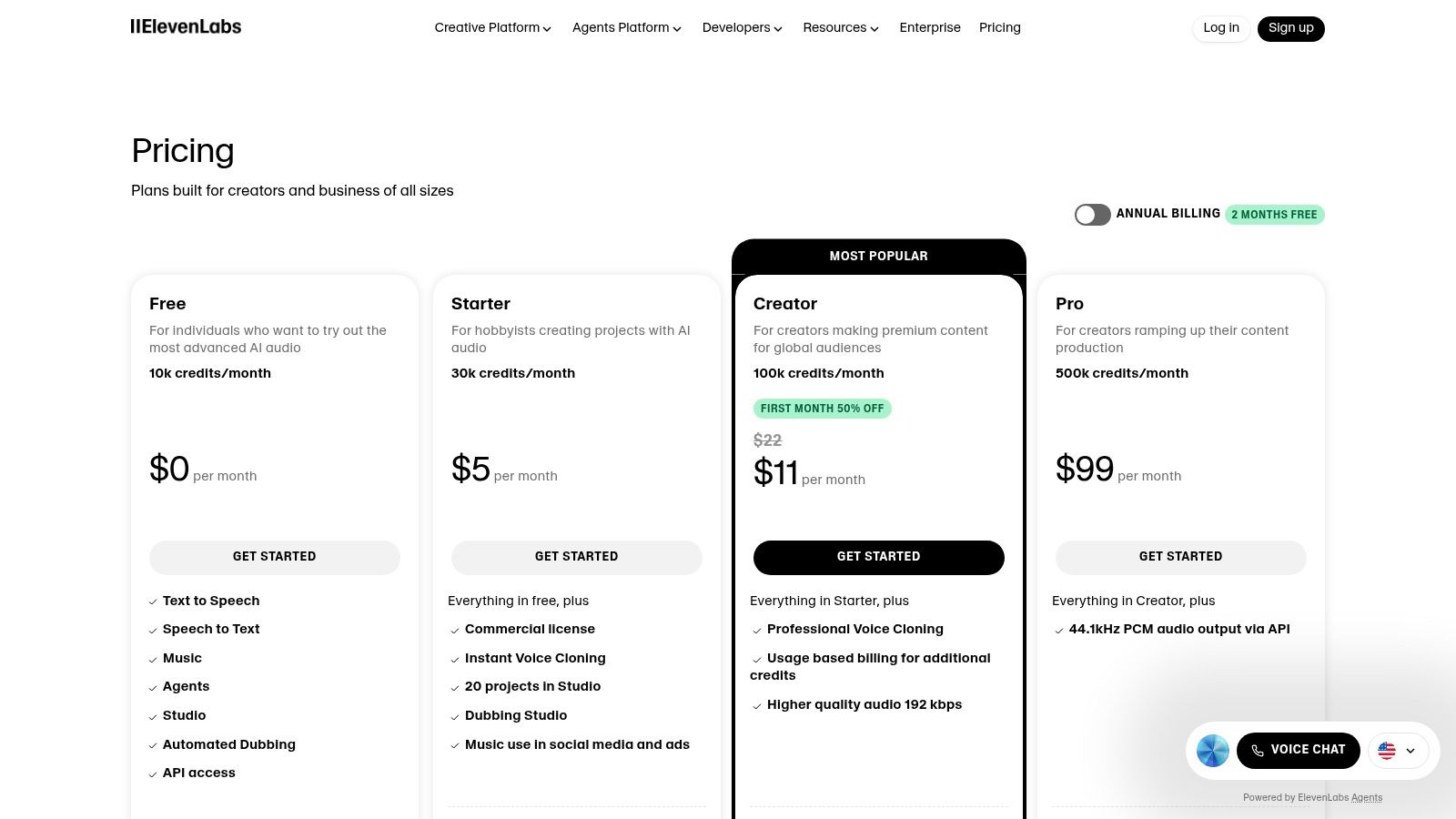
What distinguishes ElevenLabs is its balance of accessibility for individual creators and robust functionality for enterprise use. Its API allows developers to integrate high-quality voice generation directly into their applications, while the user-friendly studio interface serves marketers and producers without coding expertise. For creative directors managing global campaigns, the platform’s dubbing capabilities across over 70 languages provide an efficient solution for localising video content while maintaining vocal consistency and IP compliance. This combination makes it one of the most versatile ai tools for content creation in the audio space.
Key Features and Implementation
- Plan Tiers: A free tier offers a starting point, with paid plans (Starter, Creator, Pro) providing more characters, custom voices, and higher-quality audio. Enterprise plans are available for large-scale needs.
- Professional Voice Cloning: Teams can create a digital replica of a specific voice, ensuring brand consistency across all audio content, from advertisements to internal training modules.
- API Access: Developers can seamlessly integrate ElevenLabs' voice generation into custom workflows, applications, and content management systems for automated audio production.
- Pros: Among the most natural-sounding AI voices available, flexible for both creators and developers, transparent credit system for usage planning.
- Cons: Heavy usage can become costly and require higher tiers, some advanced features are gated to more expensive plans.
Website: https://elevenlabs.io/pricing
11. AppSumo – AI Collection
Best For: Cost-effective discovery and testing of emerging visual AI tools for budget-conscious teams.
For creative teams seeking to explore a wide range of specialised AI tools without significant financial commitment, AppSumo's AI Collection serves as an essential marketplace. It offers a rotating selection of heavily discounted and lifetime deals on emerging SaaS products, covering everything from niche AI copywriters and video repurposers to image generators and marketing automation platforms. This model allows teams to experiment with various ai tools for content creation at a low entry cost.

What distinguishes AppSumo is its value proposition for budget-conscious project managers and marketers. Instead of committing to expensive annual subscriptions for unproven software, teams can acquire lifetime access to promising tools for a one-time fee. The platform's transparent user reviews and generous refund policy provide a layer of security, helping teams vet early-stage products that may not have established reputations. This makes it an ideal resource for augmenting a core creative stack with specialised, cost-effective solutions.
Key Features and Implementation
- Deal Tiers: Most deals are structured as lifetime licences with tiered pricing, offering more features or higher usage limits at each level. One-time payment is the standard model.
- Curated AI Collection: The platform specifically curates and showcases AI-powered tools, making it easy to discover new and relevant software for creative and marketing workflows.
- User Reviews and Vetting: Each product listing includes extensive reviews, questions, and founder responses, providing critical insights into a tool's capabilities and long-term viability.
- Pros: Highly cost-effective for testing and acquiring multiple AI tools, broad variety of niche applications, transparent community feedback.
- Cons: Product quality and long-term support can be inconsistent as many tools are from early-stage start-ups; deals are time-limited.
Website: https://appsumo.com/collections/features/ai
12. G2 – AI Writing Assistants
Best For: Vetting and comparing enterprise-ready AI writing tools with verified, impartial user feedback.
For teams navigating the crowded market of ai tools for content creation, G2 serves as a critical third-party validation and discovery platform. Rather than being a tool itself, it’s a comprehensive aggregator of user reviews, satisfaction scores, and comparative data for AI writing assistants that support visual projects. This makes it an essential resource for project managers and creative directors tasked with shortlisting vendors, as it provides a clear, market-wide view of available solutions.
G2 excels at helping enterprises make informed procurement decisions. It aggregates real-world feedback on everything from implementation and support to feature performance, which is invaluable for vetting tools before committing to a subscription. Its grid-based ranking system allows for quick visual comparisons based on user satisfaction and market presence. For teams needing to justify a new software investment, G2 provides the impartial, user-driven data needed to build a strong business case, ensuring the chosen tool aligns with specific workflow requirements and security standards.
Key Features and Implementation
- Verified User Reviews: Access detailed feedback from real users, providing insights into the practical application and limitations of various AI writing tools.
- Comparison Grids: Visually benchmark products against each other using G2's proprietary Grid® reports, which plot tools based on satisfaction and market presence.
- Advanced Filtering: Narrow down options by company size, specific features, industry, or user satisfaction ratings to quickly find relevant solutions for your team's needs.
- Pros: Offers broad coverage of mainstream and niche tools; user reviews provide authentic insights for validating choices.
- Cons: Sponsored placements can affect the visibility of some vendors; detailed pricing often requires navigating to the individual tool's website.
Website: https://www.g2.com/categories/ai-writing-assistant
Top 12 AI Content Creation Tools — Feature Comparison
Final Thoughts
The landscape of visual content creation is undergoing a seismic shift, driven by the rapid evolution of artificial intelligence. As we've explored, the array of AI tools for content creation is no longer a futuristic concept but a present-day reality, offering tangible solutions for creative teams, marketers, and developers. From generating photorealistic 3D assets with Virtuall to producing commercially safe brand imagery with Adobe Firefly, these technologies are fundamentally reshaping creative workflows, enabling unprecedented speed, scale, and innovation.
Our journey through tools like Canva's Magic Studio, Descript, and Runway has demonstrated that AI is not a replacement for human creativity but a powerful collaborator. It automates laborious tasks, streamlines complex processes, and opens up new avenues for artistic expression that were previously impractical or impossible. The key takeaway is not simply that these tools exist, but that they are becoming increasingly specialised and enterprise-ready, catering to distinct needs across text, image, audio, video, and 3D design.
Choosing Your AI Co-Pilot: A Strategic Approach
Navigating this expansive ecosystem can feel daunting. The sheer volume of options, each with unique strengths and pricing models, requires a thoughtful selection process. To select the right AI tools for content creation for your specific needs, consider the following strategic framework:
- Define Your Primary Use Case: Are you a marketing team focused on scaling social media visuals (consider Canva), or a game development studio needing to rapidly generate 3D props (where a tool like Virtuall excels)? Your core requirement should be your North Star.
- Assess Integration and Workflow Compatibility: The best tool is one that seamlessly fits into your existing processes. Evaluate API access, compatibility with your current software stack (like Adobe Creative Cloud), and the learning curve for your team. A powerful tool that disrupts your workflow is ultimately inefficient.
- Evaluate the Cost-to-Value Ratio: Free and freemium models are excellent for experimentation, but professional use often requires a subscription. Analyse the pricing tiers against the features you will actually use. Does the tool save enough time or generate enough value to justify the investment?
- Prioritise Enterprise-Readiness and Compliance: For creative agencies, studios, and larger organisations, factors like data security, user management, and intellectual property rights are non-negotiable. Always investigate a provider's policies on data usage and content ownership to ensure they align with your corporate and client standards. This is a critical step in adopting AI responsibly.
The Road Ahead: Embracing an Augmented Creative Future
The true power of these platforms is realised when they are combined, creating a synergistic AI-powered production pipeline. A marketer might use ChatGPT for ideation, Jasper for drafting, Adobe Firefly for blog imagery, and Descript for a promotional video. Similarly, a 3D artist could leverage AI for concept art before moving to a specialised platform to generate the final assets.
The field is also expanding at a blistering pace. To discover even more innovative solutions and expand your AI toolkit, explore platforms like Shortgenius, which offers unique capabilities for content creation. Staying informed and adaptable is crucial.
Ultimately, the successful integration of AI tools for content creation hinges on a strategic mindset. It's about empowering human talent, not supplanting it. By offloading repetitive tasks and providing powerful new capabilities, these tools free up creative professionals to focus on what they do best: strategy, storytelling, and groundbreaking ideation. The future of content creation is not human versus machine; it is human augmented by machine, a partnership poised to redefine the boundaries of what's creatively possible.
Ready to revolutionise your 3D asset pipeline? Virtuall leverages generative AI to create high-quality, game-ready 3D models from simple text prompts or images, dramatically accelerating your workflow. Discover how our enterprise-ready platform can empower your creative team by visiting Virtuall today.

